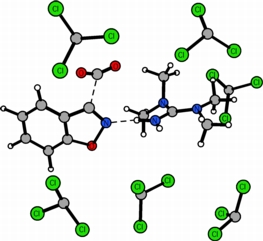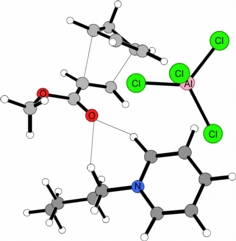Research Interests
Our research program focuses upon the application and development of new computational tools that target organic and enzymatic catalyst design, alternative environmentally friendly solvent design, and drug discovery. Fundamental problems in organic and medicinal chemistry are probed, such as elucidation of enzymatic reactions, controlling enantioselectivity for chiral compounds, transition structure prediction, de novo design of high-affinity inhibitors, and origins of drug resistance. Obtaining quantitative success with large-scale quantum and molecular mechanical calculations involves the development of improved force fields, software, and methodology.
Solvent Effects and Catalysis
 Background: The effect of solvent on chemical transformations is highly sensitive,
typically giving noticeable improvement in rate acceleration and stereoselectivity when
transferring from water to dipolar aprotic solvents. Many substitution and elimination
reactions owe this acceleration to a greater charge differential stabilization of
charged substrates and more charge delocalized transition structures via hydrogen bonding
in protic solvents which is not possible in aprotic ones. The high catalytic efficiency
of enzymes is due to in part to a similar destabilization by extraction of the reactants
from water into the low-dielectric pocket of the binding site. To gain a deeper appreciation
of enzymatic catalysis, it is essential to understand the properties and structure of the
transition structure. The focus of our work is to shed light on the role of transition
states in enzymatic catalysis, by formulating a better understanding on how the immediate
molecular environment surrounding the transition structure affects the rate and selectivity
of fundamentally important reactions.
Background: The effect of solvent on chemical transformations is highly sensitive,
typically giving noticeable improvement in rate acceleration and stereoselectivity when
transferring from water to dipolar aprotic solvents. Many substitution and elimination
reactions owe this acceleration to a greater charge differential stabilization of
charged substrates and more charge delocalized transition structures via hydrogen bonding
in protic solvents which is not possible in aprotic ones. The high catalytic efficiency
of enzymes is due to in part to a similar destabilization by extraction of the reactants
from water into the low-dielectric pocket of the binding site. To gain a deeper appreciation
of enzymatic catalysis, it is essential to understand the properties and structure of the
transition structure. The focus of our work is to shed light on the role of transition
states in enzymatic catalysis, by formulating a better understanding on how the immediate
molecular environment surrounding the transition structure affects the rate and selectivity
of fundamentally important reactions.
Objective: The aim is to develop and use computational methods to gain physical
insight into how external factors (catalysts or solvent) enhance the rate or stereoselectivity
of chemical reactions. For many reactions the role of solvent has been assumed to be static,
hence its effect is basically thought to be a contribution of solvation energy to the total
free energy of the system. However, direct participation of solvent molecules may occur in
which a few critical solvent molecules bind to the transition structure and lower the
activation energy or an electric field created by the solvent changes the shape of the
potential energy surface. In extreme cases the reaction path itself can be perturbed,
especially when Lewis acids are involved. This reinforces the need for thorough studies
on the intermolecular interactions occurring between solvents, catalysts, and reactions.
Ionic Liquids
 Background: The U.S. chemical industry is the world’s largest producer of chemicals products
(value shipped, $438.8 billion in 2000), contributing the third largest trade surplus
of any non-defense-related sector to the U.S. economy, and representing 10 percent of
all U.S. manufacturing. Chemical companies depend upon volatile organic solvents that
are damaging to the environment, expensive to use and manage, and create safety issues
in production. It has been estimated that over 100 million pounds of chemical waste is
treated yearly, costing industry billions of dollars. As the need for more efficient and
cleaner technologies becomes increasingly important, the search for alternatives to the
most costly and environmentally damaging solvents is becoming an immediate priority. One
promising possibility is the use of room temperature ionic liquids.
Background: The U.S. chemical industry is the world’s largest producer of chemicals products
(value shipped, $438.8 billion in 2000), contributing the third largest trade surplus
of any non-defense-related sector to the U.S. economy, and representing 10 percent of
all U.S. manufacturing. Chemical companies depend upon volatile organic solvents that
are damaging to the environment, expensive to use and manage, and create safety issues
in production. It has been estimated that over 100 million pounds of chemical waste is
treated yearly, costing industry billions of dollars. As the need for more efficient and
cleaner technologies becomes increasingly important, the search for alternatives to the
most costly and environmentally damaging solvents is becoming an immediate priority. One
promising possibility is the use of room temperature ionic liquids.
Ionic liquids are a novel class of solvents, defined as a material containing only ionic
species, with a melting point at or below room temperature. In sharp contrast to molten
salts or melts, ionic liquids can be fluid at temperatures as low as 204 K, are colorless,
have low viscosities, high conductivity, negligible vapor pressure, excellent thermal and
chemical stabilities, are recyclable, non-explosive, easy to prepare, active at room
temperature, and tolerate impurities such as water. An exciting aspect of ionic liquids resides in their ability to provide increased
rates and selectivity for a series of industrially and academically important reactions such
as the Heck, Friedel-Crafts, isomerizations, hydrogenation, organometallic, Michael, Mannich,
Wittig, 1,3-Dipolar additions, aldol and benzoin condensations. The observed effects of ionic liquids range
from weak to powerful, but an understanding of the molecular factors are largely unknown.
Objective: The objective is to understand the microscopic details on how ionic liquids operate and to exploit this
understanding to predict new ionic liquids that give
optimal rate and stereoselectivity enhancements. A comprehensive understanding on how ionic liquids
impact chemical reactivity will be used to influence a wide range of (1) difficult organic reactions,
which benefit from toxic solvents coupled with high pressures and temperatures, and (2) enzymatic
reactions, which require complex physiological conditions. The long-term intent of our research
program is to create controllable, efficient, safe, and environmentally clean technologies that
impact society and chemistry from the laboratory bench top to large-scale industrial manufacturing.
Drug Design
 Background: A better understanding of the mechanism occurring in ACC (acetyl-CoA carboxylase),
responsible for the catalysis of malonyl-CoA, is crucial in developing treatments for
obesity and diabetes; a growing epidemic with approximately one-third of the U.S. population obese
and another one-third overweight. The cost of treating adults with obesity amounts to over $238
billion a year. A major national health objective for the year 2010 is to reduce obesity among
adults to less than 15%, however, with the current lack of effective therapeutic agents, research
indicates that the situation is worsening.
Background: A better understanding of the mechanism occurring in ACC (acetyl-CoA carboxylase),
responsible for the catalysis of malonyl-CoA, is crucial in developing treatments for
obesity and diabetes; a growing epidemic with approximately one-third of the U.S. population obese
and another one-third overweight. The cost of treating adults with obesity amounts to over $238
billion a year. A major national health objective for the year 2010 is to reduce obesity among
adults to less than 15%, however, with the current lack of effective therapeutic agents, research
indicates that the situation is worsening.
Impaired fat-burning capacity plays a large role in the failure for many individuals to reduce
body mass. One method for developing anti-obesity agents lies in improving the fatty acid oxidation
potential. Malonyl-CoA inhibits carnitine palmitoyl 1 (CPT1), which is responsible for facilitating
the entry of fatty acids into the mitochondria for oxidation. Regulating the levels of malonyl-CoA
through ACC inhibition can serve as a controller for fatty acid oxidation. Experimental evidence in
mice confirms inhibition of ACC leading to a reduction in body fat.
Objective: The goal is to develop and use computational methods to make predictions on the
structure, energetics, and reactivity of biomolecular systems in order to solve biological problems
in the life sciences. The system of interest, acetyl-CoA carboxylase (ACC), uses biotin to catalyze
the formation of malonyl-CoA, playing a crucial role in the metabolism of fatty acids.
The objective of our research is the prediction and validation of potent inhibitors for
ACC and a detailed mechanistic investigation of its highly conserved biotin-binding pocket used for
catalysis.
Funding
 • Alabama Supercomputer Authority
• Alabama Supercomputer Authority
• Auburn University Faculty Mentoring Grant